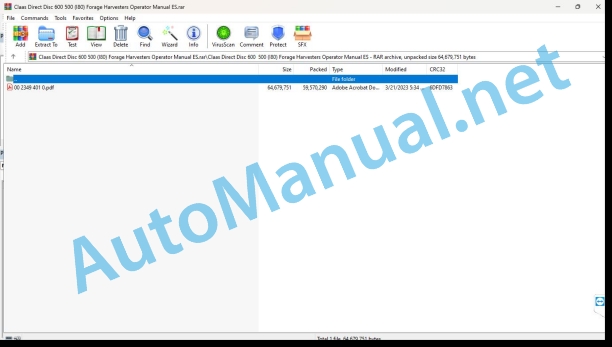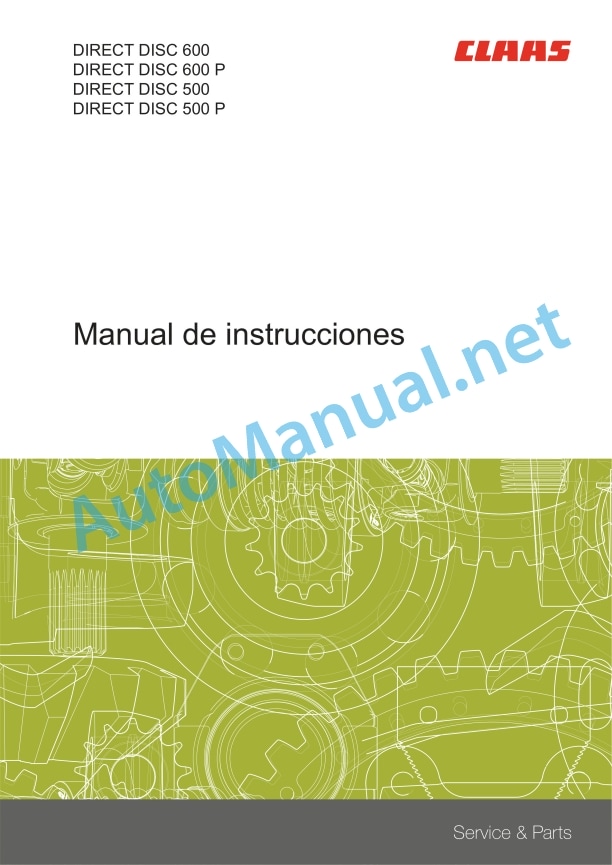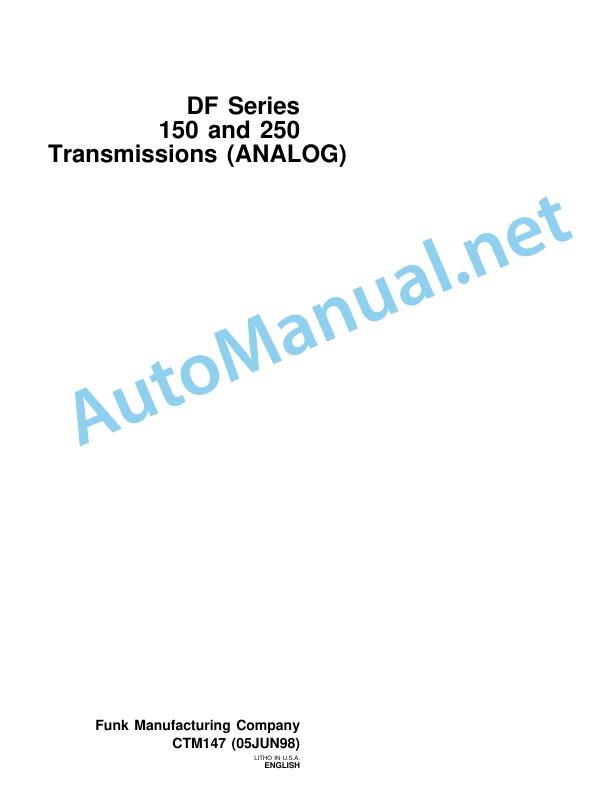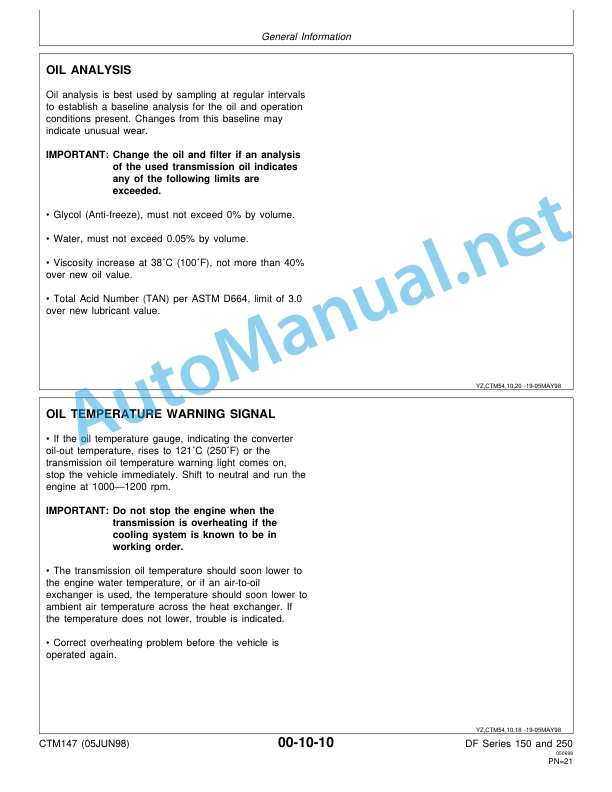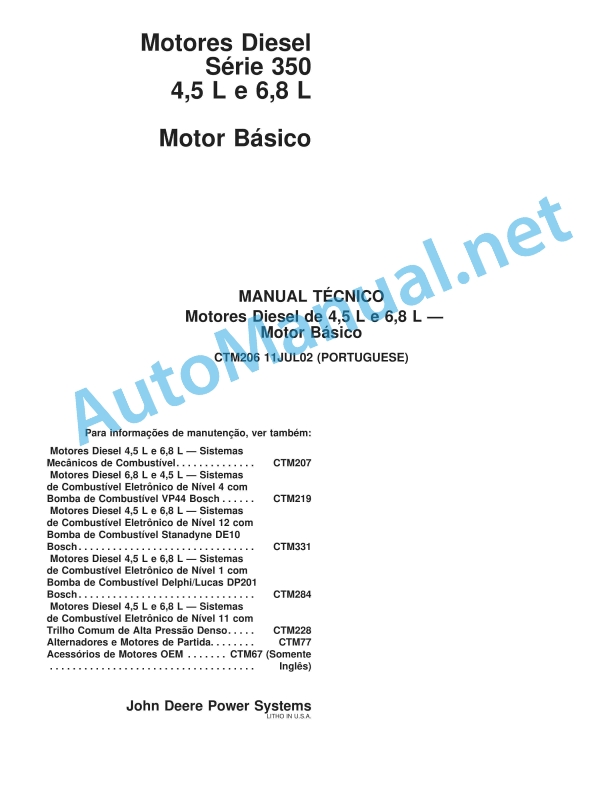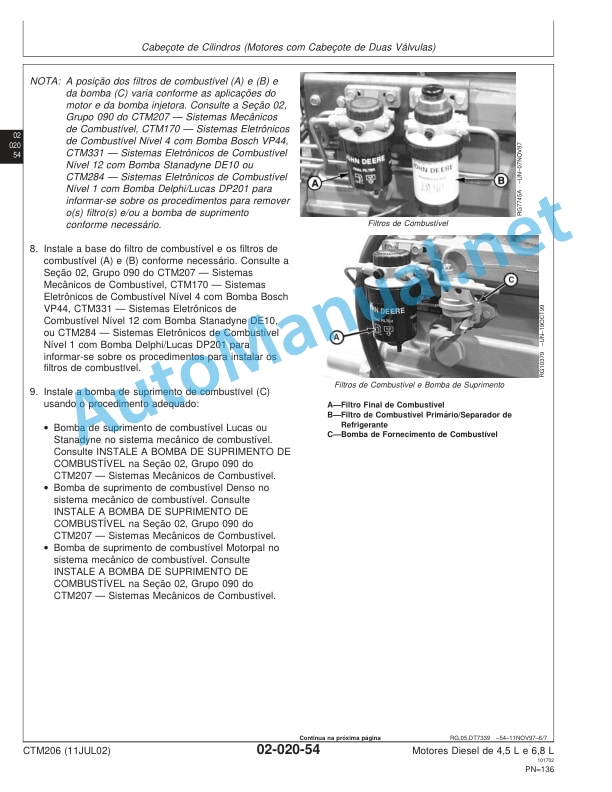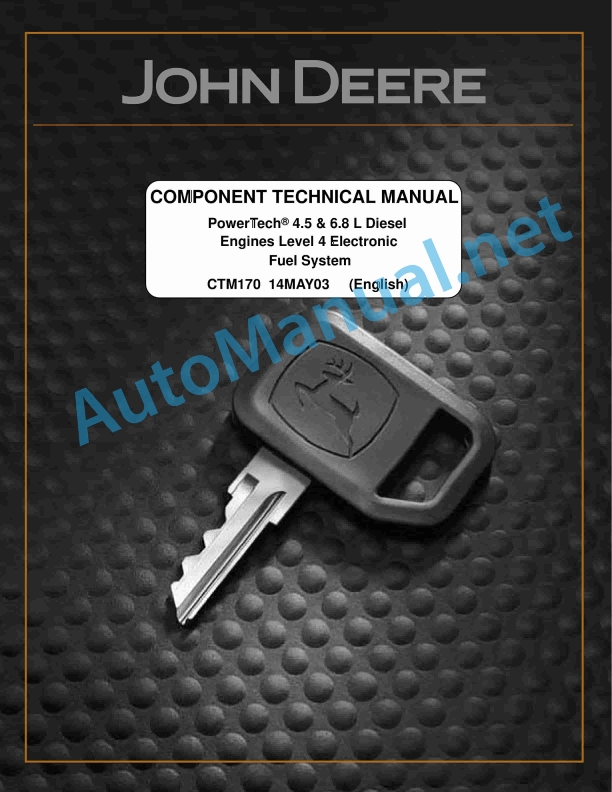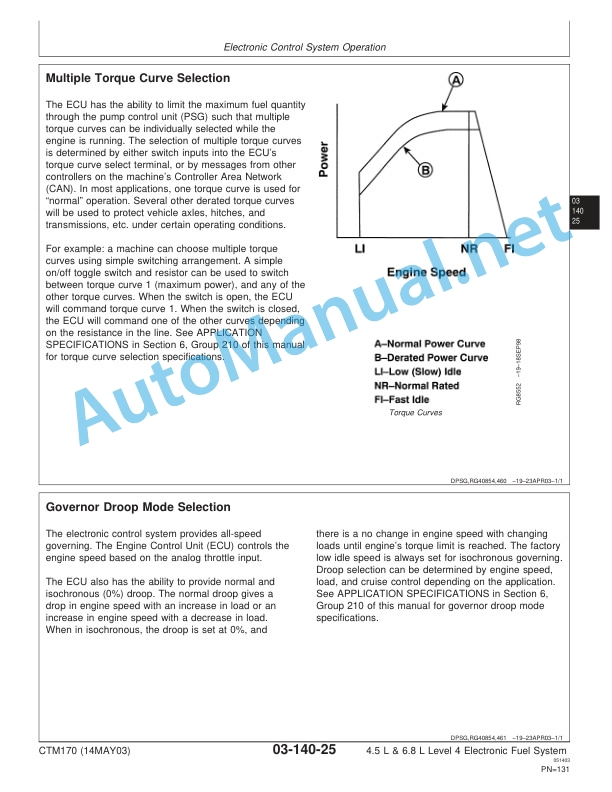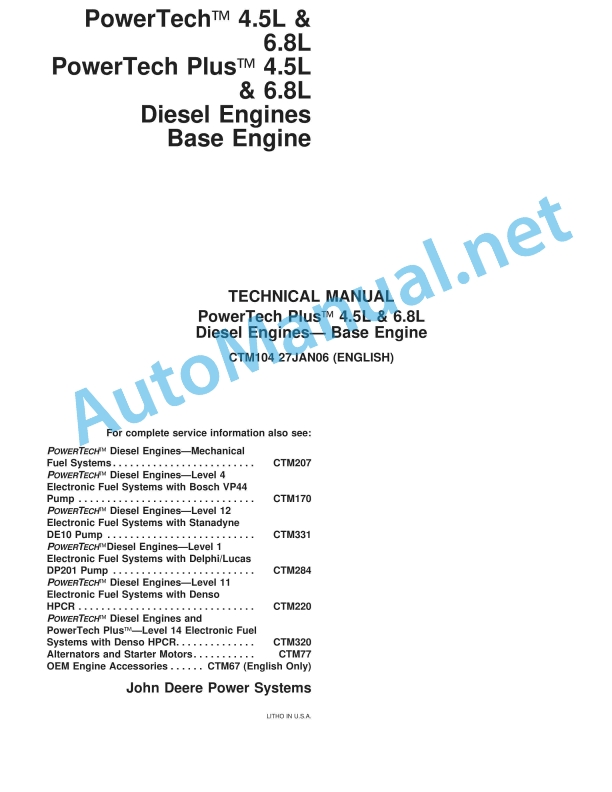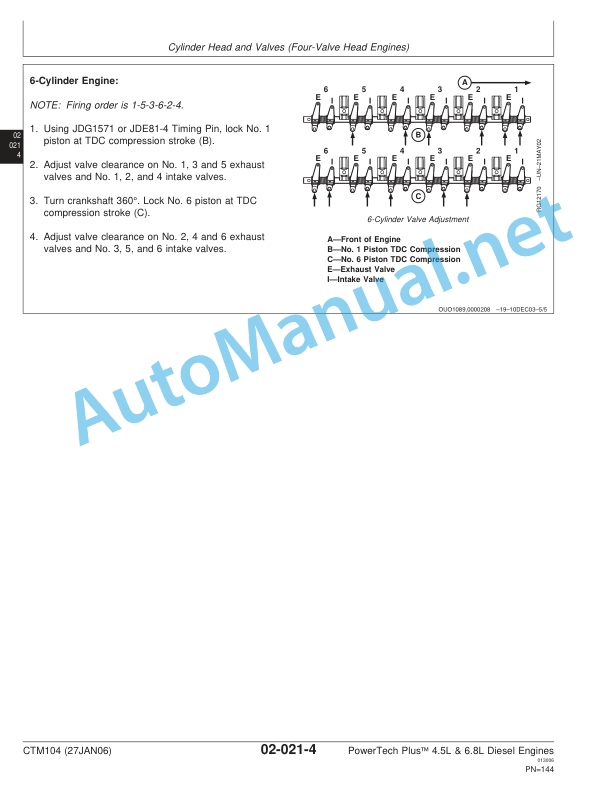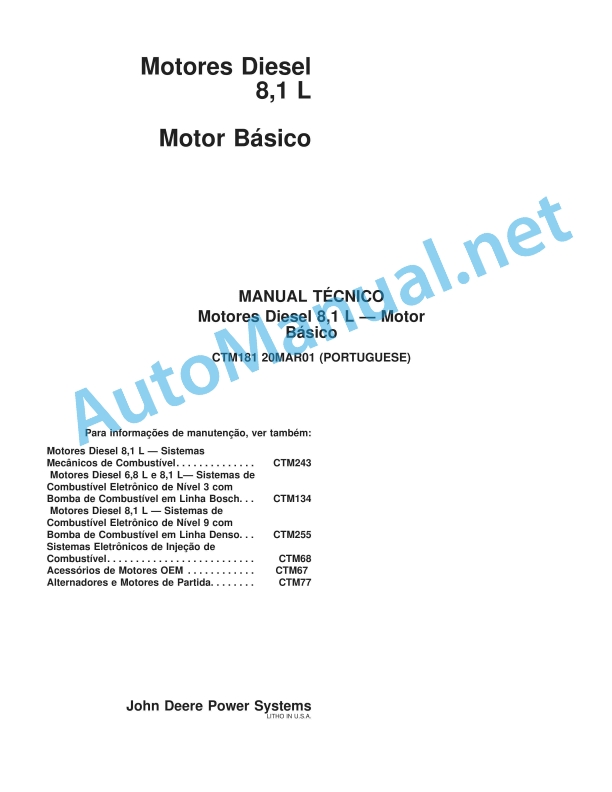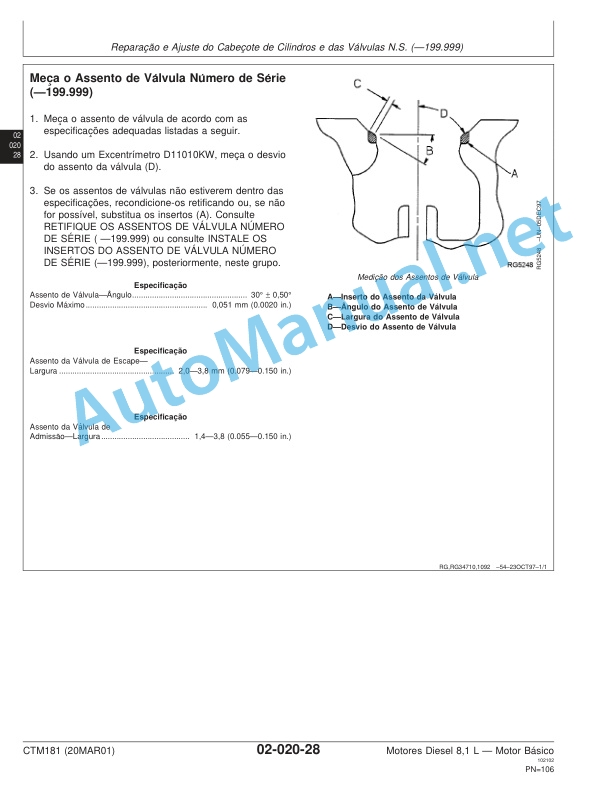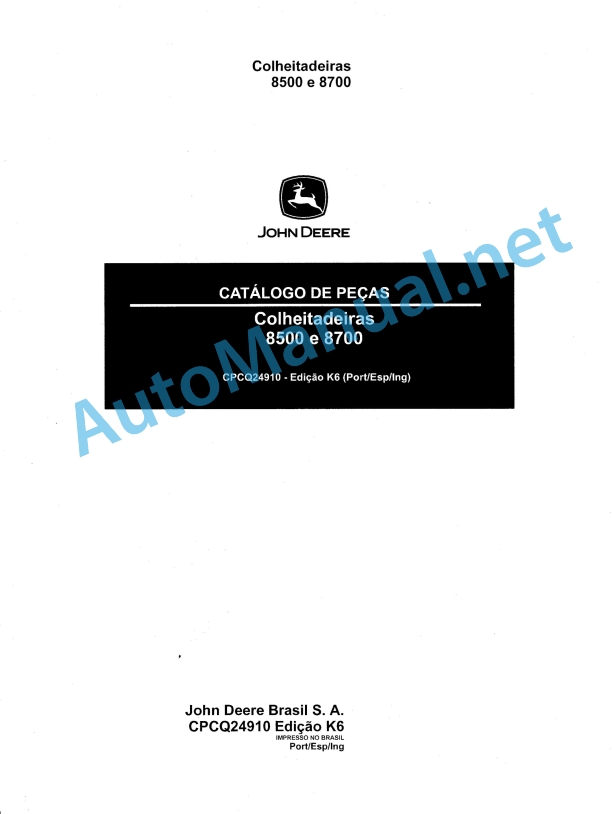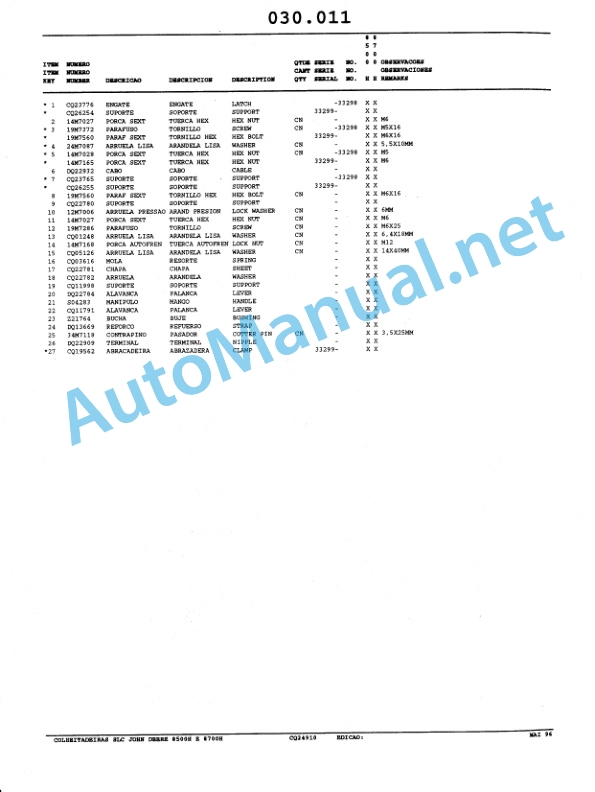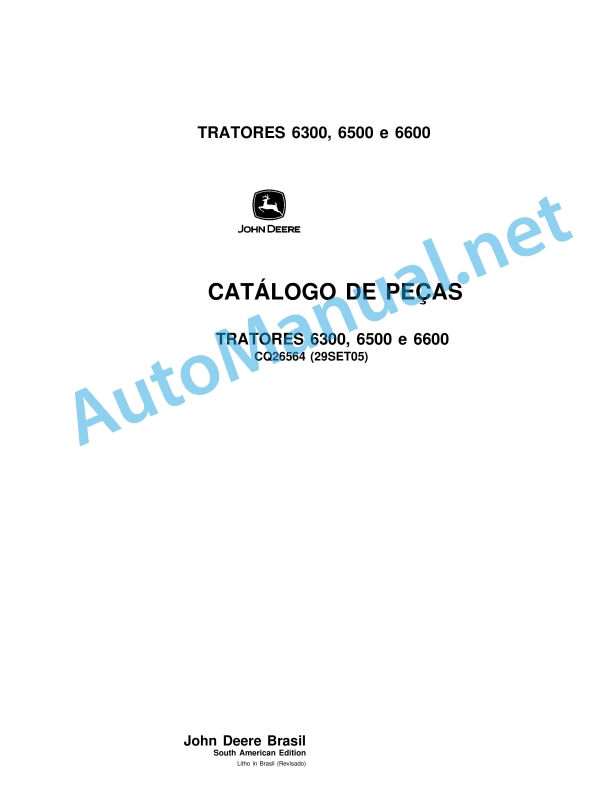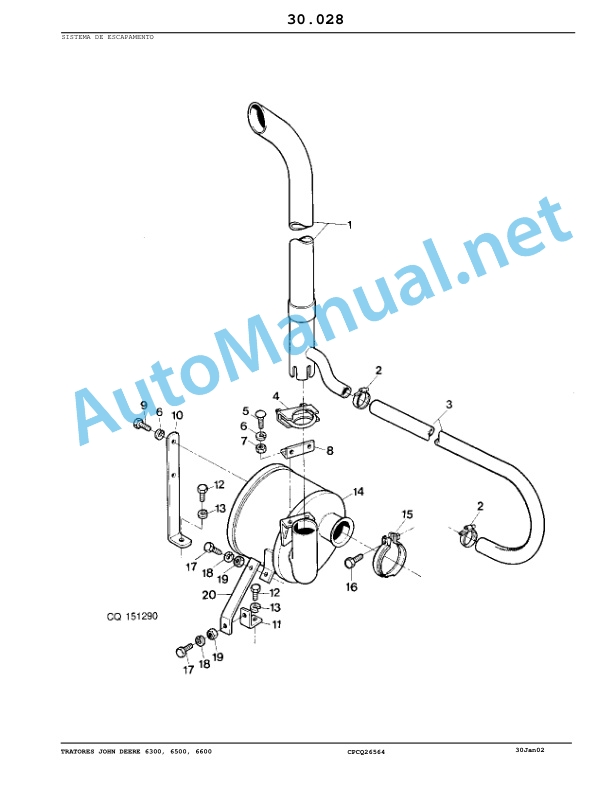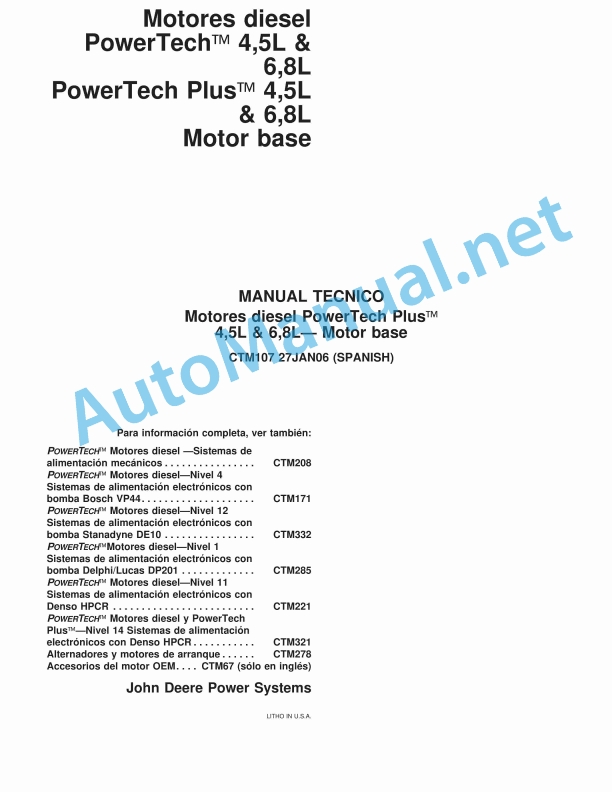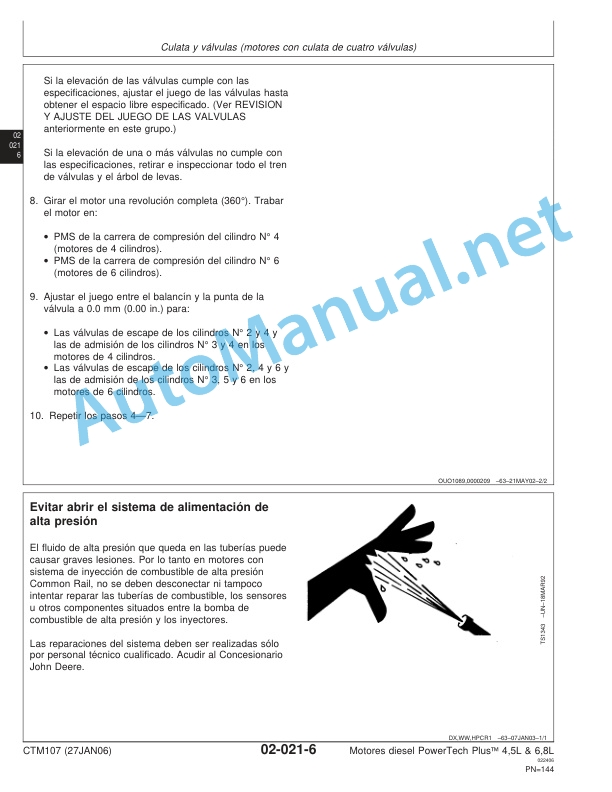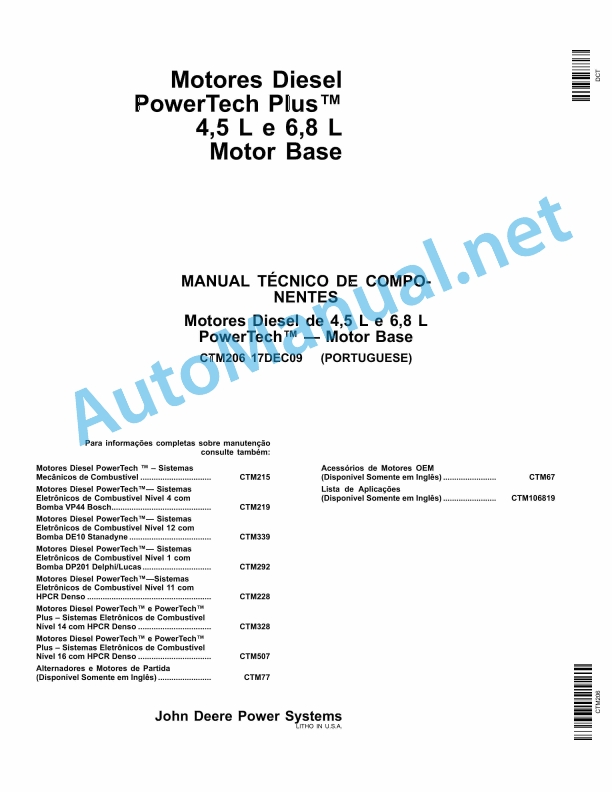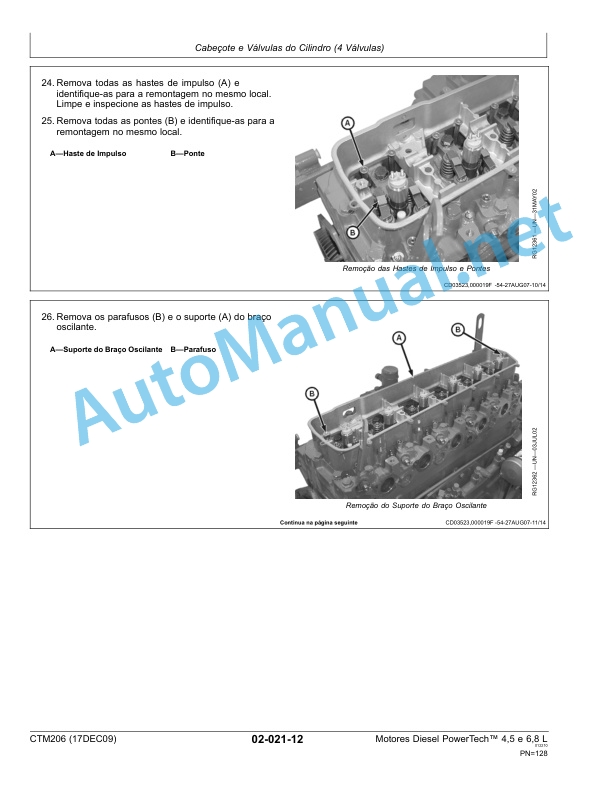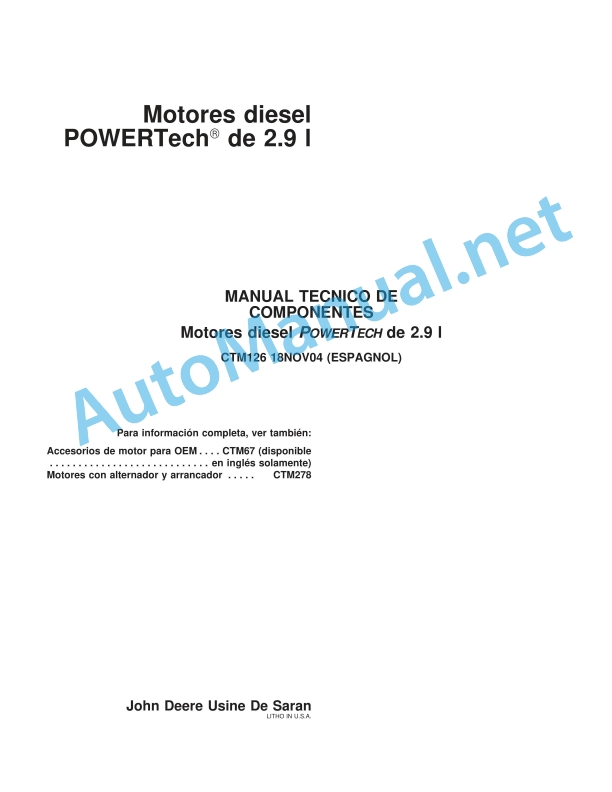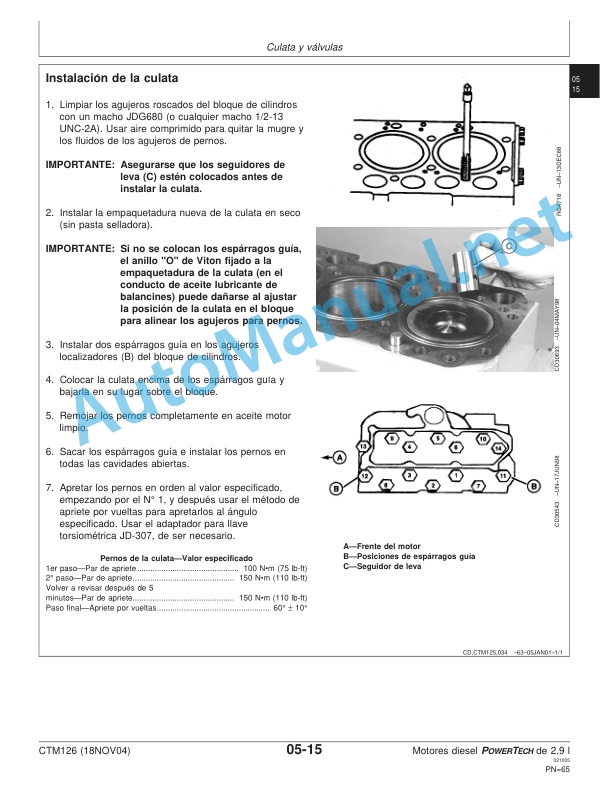Claas Direct Disc 600 500 (I80) Forage Harvesters Operator Manual ES
$50.00
- Model: Direct Disc 600 500 (I80) Forage Harvesters
- Type Of Manual: Operator Manual
- Language: ES
- Format: PDF(s)
- Size: 56.8 MB
File List:
00 2349 401 0.pdf
00 2349 401 0.pdf:
1. Introduction
1.1 Information regarding the instruction manual
1.1.1 Validity of the manual
1.1.2 Information relating to this instruction manual
1.1.3 Symbols and indications
1.1.4 Optional equipment
1.1.5 Qualified specialized workshop
1.1.6 Information regarding warranty
1.1.7 Spare parts and technical issues
1.2 Proper application of the machine
1.2.1 Proper machine application
1.2.2 Logically foreseeable inappropriate application
2 Security
2.1 Recognize warning signs
2.1.1 Danger symbols
2.1.2 Keyword
2.2 Safety instructions
2.2.1 Meaning of the instruction manual
2.2.2 Observe graphic danger symbols and alarm indications
2.2.3 Requirements for all people working with the machine
2.2.4 Children in danger
2.2.5 Danger zones
2.2.6 Position yourself between the machine and the head
2.2.7 Attach the machine to a header or transport trailer
2.2.8 Risk of injury due to rotating shafts
2.2.9 Construction modifications
2.2.10 Optional equipment and spare parts
2.2.11 Control of the machine in operation
2.2.12 Use only after correct start-up
2.2.13 Technical status
2.2.14 Danger due to machine breakdowns
2.2.15 Comply with technical limit values
2.2.16 Danger due to coasting parts
2.2.17 Maintain functional protection devices
2.2.18 Personal protective equipment
2.2.19 Wear appropriate clothing
2.2.20 Remove dirt and loose objects
2.2.21 Prepare the machine for road traffic
2.2.22 Dangers when driving on the road and in the countryside
2.2.23 Park the machine safely
2.2.24 Unsuitable consumables
2.2.25 Safe handling of consumables and auxiliary materials
2.2.26 Environmental protection and waste disposal
2.2.27 Fire protection
2.2.28 Electrical shock from electrical equipment
2.2.29 Liquids under pressure
2.2.30 Hot surfaces
2.2.31 Work only on the stopped machine
2.2.32 Maintenance work and repair work
2.2.33 Machine parts and lifted loads
2.2.34 Danger from welding work
2.3 Safety signage
2.3.1 Structure of graphic hazard symbols
2.3.2 Position of warning symbols on the machine
2.3.3 Graphic danger symbols on the dividing blades*
3 Machine Description
3.1 Summary and operation
3.1.1 Machine overview
3.1.2 Summary of drive diagram
3.1.3 Summary of the direction of rotation of the mower discs
3.1.4 Machine operating mode
3.1.5 Operating mode of paddle roller machine
3.2 Safety devices
3.2.1 Divider blade protection device*
3.3 Optional equipment
3.3.1 Conveyor caps*
3.3.2 High cut skates*
3.3.3 Wear pads*
3.3.4 Divider blades*
3.3.5 Wear strips* for feed auger
3.3.6 Hydraulic adjustment of the paddle roller*
3.3.7 Roller distributor*
3.4 Identification plates and vehicle identification number
3.4.1 Machine identification plate
3.5 Machine information
3.5.1 Adhesive on the machine
3.5.2 Adhesive on the dividing blades*
3.5.3 Adhesive on the dividing blades*
4 Control and display instruments
4.1 Control elements
4.1.1 Mounting frame
4.1.2 Divider blades*
4.2 Indicator elements
4.2.1 Frame
5 Technical data
5.1 DIRECT DISC 600 / 600P
5.1.1 Suitable machines
5.1.2 Dimensions
5.1.3 Weight
5.1.4 Version
5.1.5 Lubricants
5.2 DIRECT DISC 500 / 500 P
5.2.1 Suitable machines
5.2.2 Dimensions
5.2.3 Weight
5.2.4 Version
5.2.5 Lubricants
6 Preparation of the machine
6.1 Turn off the machine and secure it
6.1.1 Turn off the machine and secure it
6.1.2 Secure the raised head
6.2 Access jobs and maintenance positions
6.2.1 Left and right maintenance covers
6.2.2 Cover for maintenance center
Open the cover for maintenance
Close the lid for maintenance
6.2.3 Head cover
Open the hood
Close the hood
6.3 Adapt the chopper
6.3.1 Assemble the cutter bar starter clutch hydraulic connection*
6.3.2 Adjust the head in CEBIS
6.4 Adapt the head
6.4.1 Adjust the locking mechanism
6.4.2 Adjust the locking linkage
6.4.3 Check the claw coupling
6.4.4 Adjust claw clutch
6.4.5 Replacing the head drive belt
6.5 Assemble the head
6.5.1 Open the locking mechanism
6.5.2 Grease the coupling flange
6.5.3 Attach the head
6.5.4 Close the interlocking mechanism.
6.5.5 Remove the support legs
6.5.6 Turn the supports upwards
6.5.7 Connect the hydraulic hose
6.5.8 Connect the hydraulic hoses*
6.5.9 Power supply connection
6.5.10 Power supply connection
6.5.11 Unlatching the oscillating frame
6.6 Disassemble the head
6.6.1 Rotate the supports to the parking position
6.6.2 Disassemble the head with support legs
6.6.3 Latching the swing frame
6.6.4 Unplug the power supply
6.6.5 Uncouple the hydraulic hose
6.6.6 Uncouple the hydraulic pipes
6.6.7 Open the locking mechanism
6.6.8 Unhook the head
6.7 Prepare for road traffic
6.7.1 Install the protection device for the dividing blades*
6.7.2 Turn the dividing blades* to the transport position
6.7.3 Placing the header on the transport trailer
6.8 Prepare for use at work
6.8.1 Raise the head of the transport trailer
6.8.2 Adapt the head to the working conditions
A) Mowing sorghum or stocks of more than 2 m
B) Normal integral plant silage mowing (GPS)
C) Short and dry integral plant silage mowing (GPS)
D) Mowing of lying stock
6.8.3 Adapt the head to the working conditions
A) Normal integral plant silage mowing (GPS)
B) Short and dry integral plant silage mowing (GPS)
C) Mowing of lying stock
6.8.4 Turn the dividing knives* to the working position
6.8.5 Remove the protection device from the dividing blades*
6.9 Load the head
6.9.1 Raise the head
7 Management
7.1 Driving on the road
7.1.1 Circulation on public roads
7.2 Settings for use at work
7.2.1 Adjust cutting height
7.2.2 Adjust the cutting angle
7.2.3 Adjust the cutting length
7.2.4 Adjust the distributor
Adjust the height of the distributor
Adjust the length of the distributor
7.2.5 Check angle slats and support plates
7.2.6 Adjusting the paddle roller
7.2.7 Adjust elevation limitation
7.3 Use at work
7.3.1 Turn the dividing blades* to the transport position
7.3.2 Turn the dividing knives* to the working position
7.3.3 Connecting and disconnecting the dividing blades*
Connect the left dividing blade
Disconnect the left dividing blade
Connect the right dividing blade
Disconnect the right dividing blade
7.3.4 Using the head
7.3.5 Connect the head
7.3.6 Raise and lower the head
7.3.7 Switching cutting height control on and off
7.3.8 Raising and lowering the paddle roller
7.3.9 Raise and lower the hydraulic distributor
7.3.10 Reverse the direction of travel of the head
7.3.11 Disconnect the head
7.3.12 Take into account during the field trip
7.3.13 Mowing technique
7.3.14 Instructions on mowing
7.3.15 Difficult harvest conditions
7.3.16 Recommendation regarding environmental protection
8 Incident and solution
8.1 Summary of incidents
8.1.1 Incidents on the machine
8.1.2 Incidents in the paddle roller machine
8.1.3 Faults in the dividing blades*
8.2 Electrical and electronic system
8.2.1 Adjust the speed sensor
8.3 Mowing device
8.3.1 The mower disc does not rotate
8.4 Assembly parts
8.4.1 Swing frame hangs on one side downwards
Control horizontal position
9 Maintenance
9.1 Summary of maintenance intervals
9.1.1 Before harvest
9.1.2 After the first 50 hours of service
9.1.3 Every 8 hours of operation or daily
9.1.4 Every 50 hours of service
9.1.5 Every 250 hours of service
9.1.6 Every 500 hours of service or annually
9.1.7 After harvest
9.2 Gearbox
9.2.1 Check the tightness of the gear
9.2.2 Check the main gear oil level
9.2.3 Change main gear oil
9.2.4 Check the timing gear oil level
9.2.5 Change the timing gear oil
9.2.6 Check the bevel gear oil level
9.2.7 Change bevel gear oil
9.2.8 Check the spur gear oil level
9.2.9 Change spur gear oil
9.3 Clutch
9.3.1 Check the overload clutch
9.3.2 Check the friction clutch
9.3.3 Ventilate the friction clutch
Disassemble
Ventilate
9.3.4 Clean the cardan shaft ratchet clutch
9.4 Cardan shaft
9.4.1 Maintenance of cardan shafts
9.4.2 Remove and install the cardan shaft protection cone
9.5 Drives
9.5.1 Check the blade roller drive chain
9.6 Hydraulic installation
9.6.1 Check the hydraulic hoses
9.7 Harvest harvest
9.7.1 Check the guide strips of the dividing blades*
9.7.2 Check the oil level in the hydraulic tank of the dividing blades*
9.7.3 Change the hydraulic oil of the dividing knives*
Drain hydraulic oil
Fill hydraulic oil
9.7.4 Change the hydraulic tank return filter*
9.7.5 Check the dividing blade drive belts*
9.7.6 Tension the dividing blade drive belts*
9.7.7 Check the blade divider blades*
9.7.8 Changing the blade divider blades*
Remove the blades
Assemble blades
9.8 Power supply unit
9.8.1 Adjust the tension of the feed auger spring
9.9 Mowing device
9.9.1 Check the oil level and oil quality of the cutter bars
9.9.2 Change the cutter bar oil
Drain oil from the left cutter bar (A)
Drain oil from the right cutter bar (B)
9.9.3 Check the oil level and oil quality of the cutter bars
9.9.4 Change the cutter bar oil
9.9.5 Check the mower blades
9.9.6 Change the mower blades
9.9.7 Check the blade support
9.9.8 Clean the feed drum outlet hole
9.9.9 Check the feed drum wear strips
9.9.10 Check the feed drum cover
9.9.11 Check the feed drum sealing washer
9.9.12 Check the mower discs
9.9.13 Replacing the mower discs
9.9.14 Setting the winding protection
9.9.15 Check the intermediate pieces
9.10 Assembly and body parts
9.10.1 Check the pivoting frame pull springs
9.10.2 Adjust the oscillating frame pull springs
9.10.3 Eliminate crop remains
9.10.4 Clean the machine
9.10.5 Maintain the machine
9.10.6 Check the fixing material
9.11 Greasing scheme
9.11.1 Grease the lubrication points every 50 hours of service
9.11.2 Grease the lubrication points every 250 hours of service
10 Decommissioning and waste disposal
10.1 General information
10.1.1 Decommissioning and waste disposal
11 EC declaration of conformity
11.1 DIRECT DISC 600 / 600P / 500 / 500P
11.1.1 EC declaration of conformity
12 Technical dictionary and abbreviations
12.1 Terms and explanations
12.1.1 Abbreviations
12.1.2 Technical vocabulary
John Deere Repair Technical Manual PDF
John Deere DF Series 150 and 250 Transmissions (ANALOG) Component Technical Manual CTM147 05JUN98
John Deere Repair Technical Manual PDF
John Deere Repair Technical Manual PDF
John Deere Repair Technical Manual PDF
John Deere Repair Technical Manual PDF
John Deere Parts Catalog PDF
John Deere Harvesters 8500 and 8700 Parts Catalog CPCQ24910 Spanish
John Deere Parts Catalog PDF
John Deere Tractors 6300, 6500, and 6600 Parts Catalog CQ26564 (29SET05) Portuguese
John Deere Repair Technical Manual PDF
John Deere Repair Technical Manual PDF
John Deere Repair Technical Manual PDF
John Deere Diesel Engines POWERTECH 2.9 L Component Technical Manual CTM126 Spanish

